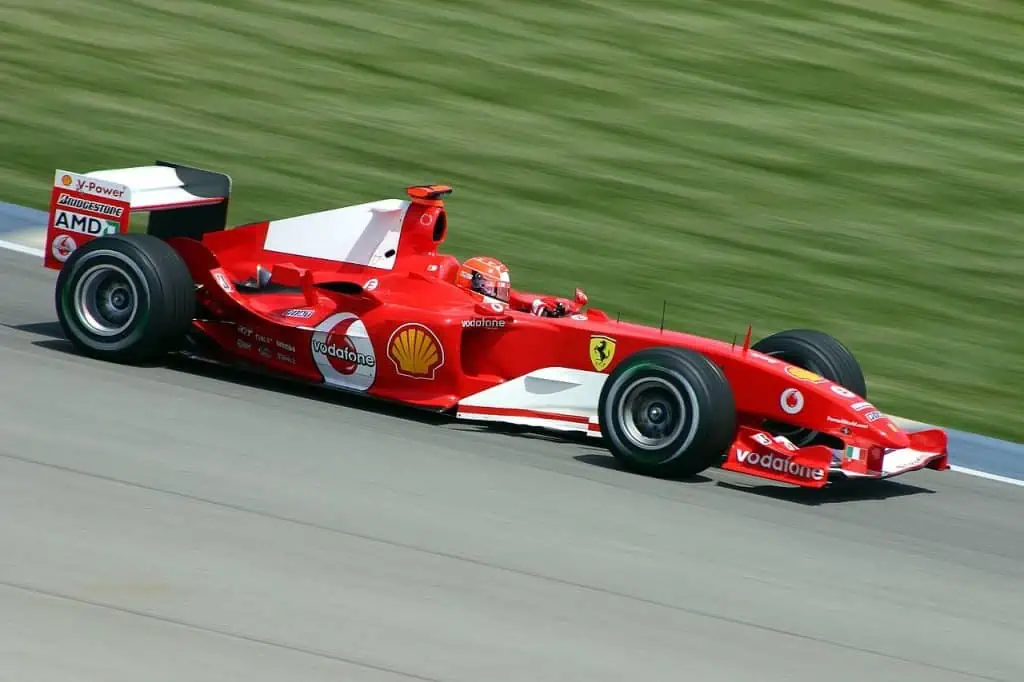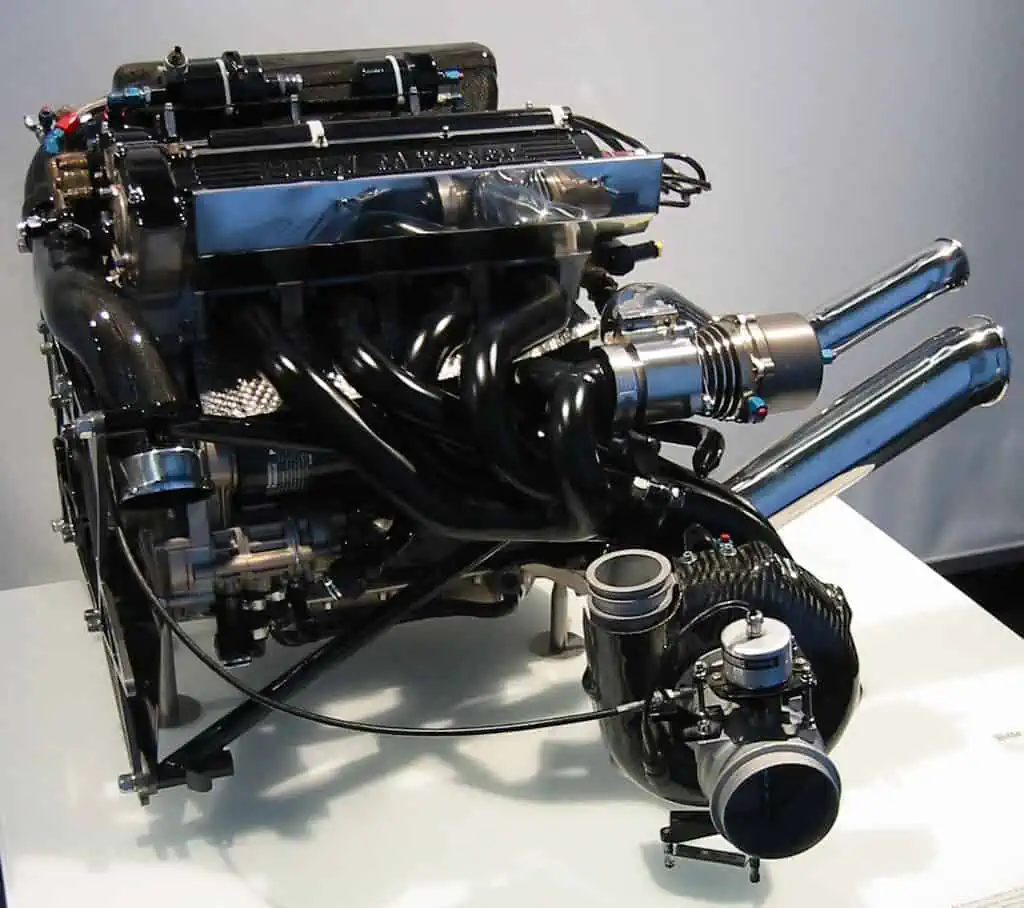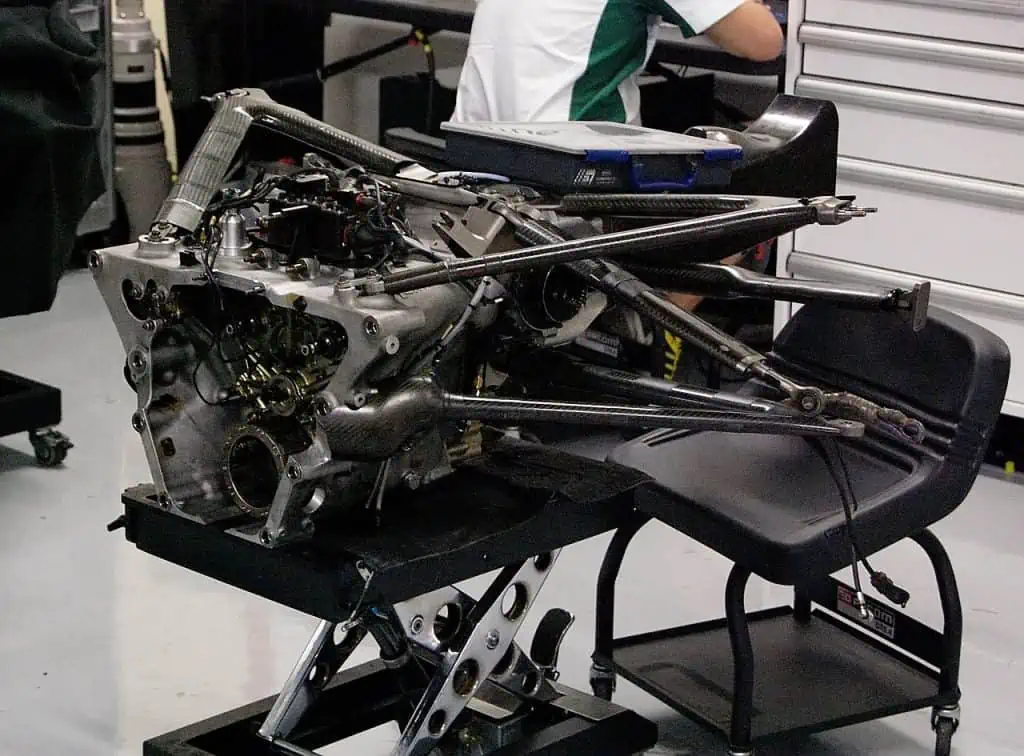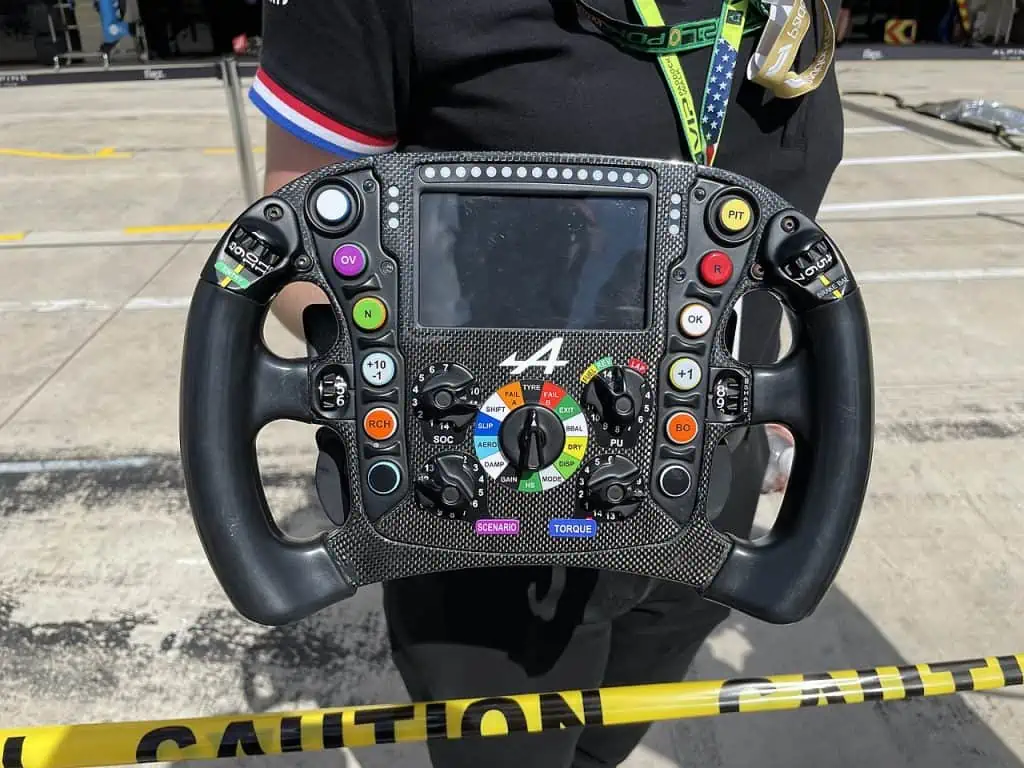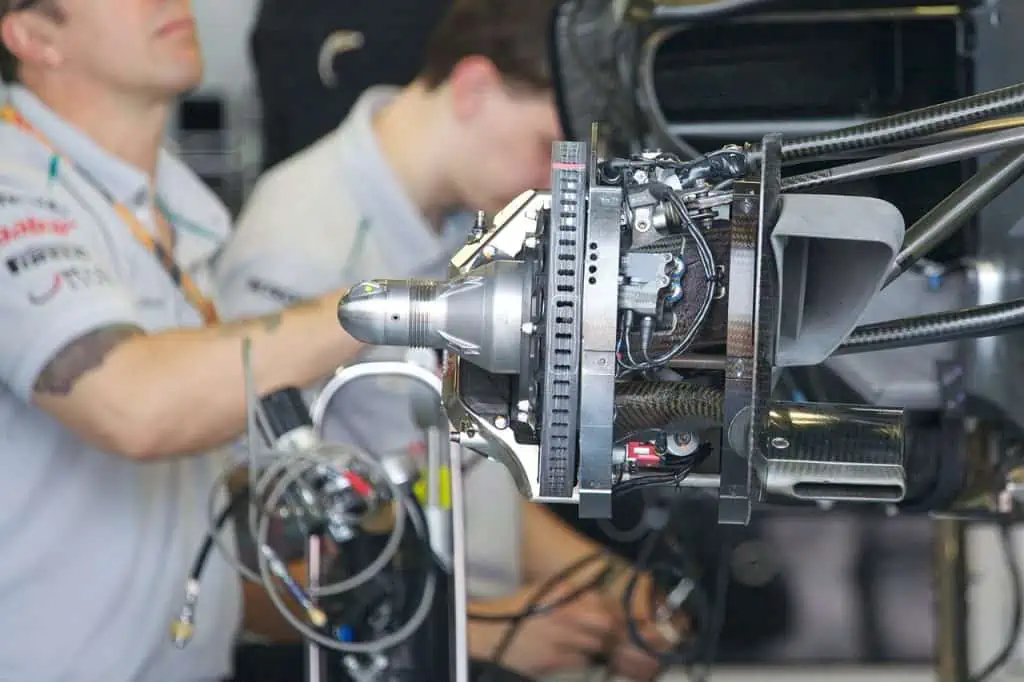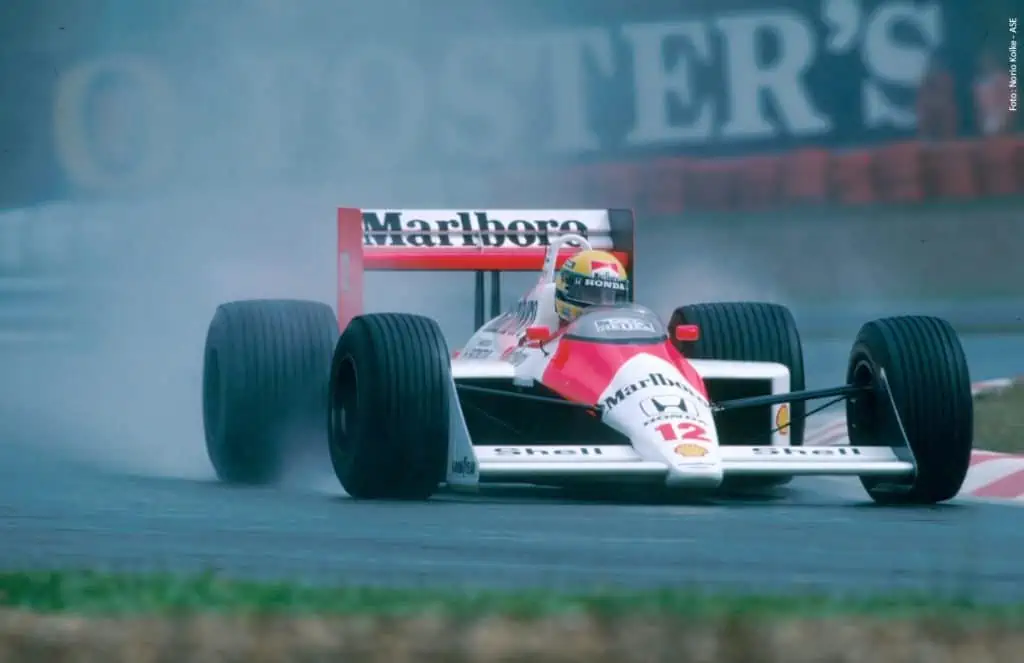Although F1 cars are among the most costly on the market, they are also exceedingly flimsy. These devices are state-of-the-art and loaded with cutting-edge technology. Although they are always innovating and pushing the envelope of engineering, machines are extremely expensive.
The cost to develop an F1 car can be more than $20 million, however, it will differ between the teams. The most expensive component of a car, frequently costing $10 million or more, is the engine. Another factor contributing to the high cost of F1 cars is the use of sophisticated materials like carbon fiber in their construction.
It’s amazing how teams manage to stay in the sport given the high cost of the cars. The perception of F1 as the playground of the affluent and famous has never changed. We go into great detail on the costs associated with building an F1 car below.
What are the Costs Involved In Building an F1 Car?
Building an F1 car can cost $14 to $20 million or more. The precise figure is not known, though, as F1 teams don’t make their financial information public. These automobiles are made with a lot of labor and expensive materials, including a lot of carbon fiber, which drives up the cost.
An F1 car costs a fortune to build. Every team has a factory where they develop and manufacture all of the parts for every car, right down to the nuts and bolts. Even though the teams may be producing every component individually, the cost is not reduced.
The Massive Costs
An F1 car’s construction can cost tens of millions of dollars. It is impossible to estimate the precise quantity. Like any other business, F1 teams don’t post their financial information online for public viewing. Even if that is a difficult process; the best you can do is estimate the total expenditures based on the cost of each component.
The fact that the engineers, designers, and other staff members must be paid as well when estimating the expenses of producing F1 cars is one aspect that is frequently overlooked. Each employee is very talented and skilled, therefore it’s not cheap labor either; the team will need to take excellent care of them.
The usage of unusual materials in the construction of F1 cars accounts for a substantial portion of their high cost. Carbon fiber, which is extraordinarily strong but also lightweight, is used to make F1 cars. Carbon fiber is expensive and made via a complicated process, which accounts for its high cost.
The successful Ferrari F2004 by Rick Dikeman / CC BY-SA 3.0. An F1 car’s development costs can exceed $20 million, however, they will vary amongst teams.
The Costs of Design
But in addition to the cost of making the vehicles itself, a significant portion of a season’s budget goes into the research and development stage. This is the time when engineers create the designs for the vehicle that will eventually compete on the track. This entails spending money and time on scale-appropriate models, computer programs, simulations, and wind tunnel time.
Even while a breakdown can help us comprehend the costs associated with each component of the car, it is hard to determine the actual cost of an F1 car.
There are a ton of other costs as well as prices that we won’t ever be aware of, including those for something as simple as the wheel nuts or something as complicated as the computer system built into the car.
The costs listed below are approximations; the team will determine the precise amounts.
Cost Breakdown for F1 Cars
- $700,000 for chassis
- $13 to $16 million for engine
- $400 000+ for gearbox
- $50,000 to $100,000 for steering wheel
- $150,000+ for floor
- $150,000+ for front wing
- $150,000+ for rear wing
- $20,000 for HALO
- $80,000+ for brakes
- $3,000 for tires which are supplied by Pirelli
- $150,000 for a fuel tank
- $20000 for hydraulics
How Much Is an F1 Car Chassis?
An F1 chassis can cost up to $700,000. This does not account for the costs associated with having a backup chassis available at each Grand Prix in case the primary chassis is damaged in a collision. To have backups, teams will typically build 4 for the full season.
One of the most essential components is the car’s chassis. The chassis is created at the beginning of the year and, barring significant damage, will be used the entire season. Every Grand Prix will include a backup chassis because they can get damaged in crashes.
A chassis may have a slight crack in it in certain less severe collisions, as opposed to the serious ones where we’ve seen them ripped in half. A damaged chassis can contribute to a driver’s performance deficit, especially when it comes to handling, and it can explain why they are slower than their colleague.
Switching Between the Drivers
To keep things fair between the drivers, teams frequently switch out the chassis over the season. Teams will have their setup, however, it will typically be changed either after half of the season or after each race.
BMW Formula 1-Engine by Olli1800 / CC BY-SA 3.0. The engine is the most expensive part of an F1 car, typically costing $10 million or more.
An F1 chassis can cost up to $700,000. To have a backup chassis in case one is damaged during a race weekend, teams typically build at least four for the full season. It makes sense that the chassis would need to be one of the car’s most durable components to protect the driver.
How Much Is an F1 Car Engine?
The price of an F1 engine typically ranges from $12 million to $15 million, depending on whether a team is manufacturing its own or purchasing from another team. The cost is so high because the engine is made up of intricate hybrid components that are all quite expensive.
Although F1 engines are small, they are incredibly powerful. The vehicle’s 1.6-liter V6 turbo engine, despite being relatively small, can generate over 1000 horsepower. Performing this amazing feat is extremely difficult and expensive, especially in light of the extensive research and development that has gone into the V6 hybrid engines since the 2014 season.
In addition to being among the most powerful engines in the world relative to their size, V6 turbo hybrid engines are also among the most fuel-efficient ones. The teams construct at least six of these engines for each car during a season, and they can cost more than $12 million to build.
Engine Sanctions
Although there are restrictions on each component because the engines are so complicated, drivers are permitted to use up to three engines annually. Many drivers must take extra engine parts despite the component limits before engine penalties are assessed, which would result in higher expenditures for the team.
The most expensive F1 engines in the sport’s history are those used today. The complexity of the hybrid engines, which were introduced to the sport for the 2014 season, is mostly to blame for these expenditures. For many of the team’s engineers, the engine’s complexity has been a major source of frustration.
In comparison to their predecessors, the V8s and V10s, the complicated engines are more expensive to manufacture and have more moving parts. This raises the price of the engine’s construction and maintenance. Additionally, specialized technical personnel must be hired to operate the engine both during its construction and afterward.
How Much Is an F1 Car Gearbox?
Around $400,000 can be spent on an F1 gearbox. This doesn’t account for the expense of multiple repairs and replacements that may need to be made throughout an F1 season because they are extremely delicate piece of equipment that is very simple to destroy.
The gears in F1 cars are extremely sophisticated, costing between $400,000 and $600,000 each, and they are also incredibly sensitive. The gearbox can sustain substantial damage from even a little bump at the improper angle to the rear wheels, necessitating both repairs and replacements.
Limits for Components
In F1, gearboxes are subject to the same restrictions as engines. To avoid grid penalties, teams are only permitted to use a certain amount of gearbox pieces during the season.
This regulation was implemented to rein in the soaring price of F1 cars. To conserve money and stay within the budget cap, teams are now urged to use a gearbox even if it isn’t in ideal condition, obviously to the detriment of performance.
How Much Is an F1 Car Floor?
The floor of an F1 car can cost up to $200,000. This is caused by several things, including the way they are built, which relies on the ground effect to create downforce, and the use of pricey materials like carbon fiber, which is one of them.
F1 gearbox with mounted rear suspension by John O’Nolan / CC BY 2.0. The gears in F1 cars are extraordinarily sensitive and cost between $400,000 and $600,000 each. They are also quite sophisticated and expensive.
Now more than ever, an F1 car’s floor is crucial. Background effects on automobiles have been brought on by the 2022 aerodynamic standards. This indicates that the teams now create downforce via Venturi Tunnels hidden beneath the floors of their cartoon (essentially narrow areas that generate areas of low pressure, sucking the car to the ground).
As each team seeks the ideal configuration to defeat its competitors on the track, this implies that the floor of the car became a key topic of development for this new era of the sport. Creating the floors entails figuring out the most efficient technique to direct air down the tunnels so that a vacuum can be created underneath the car.
What Ground Effect Means
The cost of designing and constructing the car’s floor has increased significantly for F1 teams as a result of the reliance on the ground effect. In the past, the car’s overall aerodynamics were mostly unaffected by the floor (although it was still hugely important).
The ground effect F1 cars of the current age can cost upwards of $150,000 to $200,000. Except for the skid plank, the flooring is built entirely of carbon fiber, one of the priciest materials used in automobile construction. The intricate design of the floors further increases the exorbitant cost. Additionally, these floors are constructed throughout the season, increasing costs.
How Much Is an F1 Car Front Wings?
The price of an F1 front wing can reach $150,000. This excludes the price of potential repairs that might be necessary for this component of the vehicle because they are so delicate and prone to damage. It is imperative that front wings are swiftly fixed because they can have a significant impact on the race.
An F1 car’s front wing is essential to the vehicle’s aerodynamic profile. Since it is the first component of the car to cut through the air, it is in charge of making sure that the air flows easily over the vehicle and into all the necessary spaces.
However, the front wing of the car is a very delicate component. The wing, or even worse, the front wing end plates, can be damaged by even the tiniest amount of contact with another vehicle, a barrier, or even a curb at an improper angle.
An Important Car Component
Given how much downforce the front wing generates, even a small piece of carbon fiber breaking off will affect how the car handles. We frequently witness drivers losing up to 0.5 seconds per lap as a result of a broken front wing.
The front wing is expensive, costing about $150,000 or more, and needs to be replaced in its whole if even a small portion of it is destroyed. The team must be competitive and keep their car in the best condition possible if they want to continue competing. There are no easy fixes available here.
How Much Is an F1 Car Rear Wings?
Building F1 rear wings can cost up to $150,000. When compared to other sections of the car, the rear wing is relatively simple to avoid repair expenses as it rarely sustains damage during a race aside from crashes. If the vehicle is damaged, the driver must typically stop racing.
An F1 car’s rear wing is just as crucial as its front wing. By creating enormous quantities of downforce, the rear wing serves to keep the car’s rear stable and keeps the rear wheels firmly on the ground, providing the car with enough cornering ability and stability.
The Drag Reduction System
The Drag Reduction System, or DRS, has emerged as one of the most crucial components of the rear wing in modern aviation. DRS is a device that enables a flap in the rear wing to be extended, increasing airflow and lowering drag. It was first introduced as an overtaking aid in 2011.
Alpine F1 steer wheel by Dmartin969. An F1 car’s steering wheel can cost anywhere from $50,000 to $100,000. This is because they are highly technological and allow owners to alter even the smallest details of their cars.
With the DRS engaged, the vehicle can travel down the straight at a few more miles per hour, providing it an advantage over other vehicles and making overtaking easier. However, the cost to adopt and maintain this technology in F1 is high.
An average F1 car’s rear wing costs about $150,000. Unless the driver is engaged in a crash, the rear wing does not sustain as much damage throughout the race. The car must be removed from the Grand Prix, though, if the rear wing is broken, as it would take too long to repair it and rejoin the race.
How Much Is an F1 Car HALO?
An F1 car’s Halo can cost up to $20,000. In 2018, the Halo, a technological and safety marvel, made its debut. The gadget continued to save many lives in both the senior formats, such as F2 and F3, and F1, despite criticism from the F1 community.
As championship rivals Max Verstappen and Lewis Hamilton demonstrated at the 2021 Italian Grand Prix, the Halo is extraordinarily sturdy and has been developed to protect the driver’s head under extreme circumstances, like as a car landing on top of another one.
The last line of protection for drivers is this highly robust device, and it has already shown that it is a necessary system that will last into the future. The Halo gadget is about $20,000 in price. Although it may be a little less expensive than the other items on this list, it is also one of the most important pieces. Without it, many drivers would find the sport to be simply too risky.
How Much Is an F1 Car Brake?
F1 brakes cost about $80,000. This pricing excludes the cost of replacing brake calipers and disc sets over a season, which could cause the costs to progressively rise over time. Brakes need to be well-maintained because they are one of a car’s most crucial components.
The brakes on an F1 car are unparalleled. While the cars’ top speeds, particularly when negotiating turns, are quite high, their stopping capability is equally outstanding and frequently disregarded.
An F1 car’s strengthened carbon fiber brakes run about $80,000. The teams will go through numerous sets of brake discs and brake calipers over the season because of the heavy use and wear these brakes endure, so the expense may mount over time.
How Much Is an F1 Car Tire?
A whole set of F1 tires costs roughly $3,000. F1 drivers utilize 13 sets of tires for a single race weekend, bringing the cost of a single racing weekend to more than $39,000 for one car’s tires alone. Pirelli provides tires to F1 teams without charge in exchange for the publicity they receive.
Incredibly excellent Pirelli tires are used by F1 cars. These tires also referred to as slick tires, have a smooth exterior. Because they provide the cars with far more grip than grooved tires, slick tires are utilized in F1. Simply said, more rubber is in contact with the tarmac due to the higher surface area.
How Much Is an F1 Car Fuel Tank?
A gasoline tank for an F1 car can cost up to $140.000. The fuel tank, which must be among the car’s strongest components and fortified to withstand any damage that can befall it, commands this price. Kevlar is one of a variety of materials used to make it.
One of the toughest and most reinforced components of an F1 car is the fuel tank. This is because the fuel tank is directly behind the driver’s seat, separating them from the hot engine that is mounted at the rear of the vehicle.
Bridgestone Potenza F1 Front Tire and BBS Wheel by Hatsukari715. The average cost of a full set of F1 tires is $3,000. For a single race weekend, F1 drivers use 13 sets of tires, which increases the cost of a single racing weekend to more than $39,000 for just one car’s tires.
However, an F1 car would turn into a bomb on wheels if this fuel tank was not strengthened. A hot engine and flammable liquid are a tragedy waiting to happen. Devastating outcomes may occur if the fuel cell was punctured, as we saw with Romain Grosjean’s crash at the Bahrain Grand Prix in 2020.
An F1 car’s fuel tank may cost between $140,000 and $150,000. The teams must make sure the gasoline tank is sturdy enough to keep the driver safe. Teams typically use a single gasoline tank for the whole of the season, but they always properly check it for flaws or damage and replace it as necessary.
How Much Is an F1 Car Hydraulics?
About $200,000 is spent on F1 hydraulics. The hydraulics system is so essential to the operation of the cars—and is required for them to even function at all—that it commands such a high price. Given the importance of the hydraulic system, cars frequently retire if they experience problems.
An F1 car’s hydraulics plays a huge role in controlling the majority of the vehicle’s moving elements. Without hydraulics, a modern F1 car would not be able to run. The hydraulics are utilized for much more than just power steering, and the drivers depend on them to function.
Failures of the hydraulic systems have frequently forced vehicles to be retired and have also caused issues for drivers. Due to a hydraulic issue, Max Verstappen encountered difficulties opening and closing his DRS during the Spanish Grand Prix of 2022.
Numerous Functions
The power steering, clutch, gearshifts, reverse gear, differential, DRS, brake by wire, throttle, inlet valves, and turbo wastegates are just a few of the numerous systems that are controlled by the hydraulics on an F1 car.
The hydraulics systems can cost more than $200,000 in total. Even if spending this much money on the engine is significant, it is necessary for the overall performance of the vehicle. Without it, the car won’t be able to drive at all, and hydraulic issues will probably force the car to retire from a Grand Prix.
How Much Is an F1 Car Steering Wheel?
A steering wheel for an F1 car costs between $50,000 and $100,000. This is because they contain a lot of technology and enable owners to modify even the most minute aspects of their vehicles. Additionally, they serve as a digital dashboard that provides them with important details about their automobile and the competition.
The steering wheel of an F1 automobile is one of its most remarkable features. These little computers, which cost a small amount to construct but have amazing bits of technology inside them, can manage just about everything and anything in the car.
The steering wheels of F1 drivers feature digital dashboards, which are effectively computers that provide them with all the specific information they require about their cars, from their position in the race to how far they are from their fastest lap times.
Responsive Setting Adjustments
Drivers should be familiar with how their steering wheels function since they frequently need to adjust the settings mid-Grand Prix to address a mechanical issue with the vehicle. These drivers are adept at fiddling with buttons while traveling at 200 mph because they are familiar with their vehicles.
Brake discs on the F1 car by Mark McArdle / CC BY-SA 2.0. About $80,000 is spent on F1 brakes. This pricing does not include the expense of replacing brake calipers and disc sets throughout the season, which could result in a gradual price increase.
The price of an F1 steering wheel ranges from $50,000 to $150,000. The driver has more control over their vehicle thanks to these amazing pieces of technology than you would ever imagine. Every modification the driver makes will affect how the automobile responds and behaves, so they must be aware of what each button on the steering wheel does.
Why are F1 Cars So Expensive?
The materials used to construct F1 cars are what drive up their price. Carbon fiber is the material of choice since they need to be highly robust while also being incredibly light. Due to the hybrid system, the engines also contribute to the cost increase, and the final price may exceed $20 million.
The price of an F1 car seems astronomical. It’s not surprising that the sport has been trying to manage costs given that each car costs $15 to $20 million or more. Due to the high cost of the cars, an F1 season’s total expenses soar while keeping them in racing condition, maintaining them, and having them repaired.
Extra Light
The materials that were used to construct F1 vehicles are mostly to blame for their high price. To be quick, F1 cars must be exceedingly light. The car is faster and more maneuverable the lighter it is. The car will move 0.3 seconds slower for every 10 kilograms (22 lbs) added to it.
The car must be as powerful as it can be while still being incredibly light. Although the material used in F1 cars is still extraordinarily durable, the cars are still fragile but are far better able to sustain a collision. Due to this, carbon fiber is the material of choice for F1 cars. The techniques required to create it make it a pricey material.
The engine is by far the most expensive component when you look at the breakdown of an F1 car’s costs. This is a result of the hybrid system and turbos, which are quite expensive to create and construct due to their complexity and significantly raise the cost of the vehicle as a whole.
The Cost of an F1 Car and the F1 Budget Cap
Every team on the grid is required to abide by a budget cap that F1 has put in place. To close the gap between larger teams and smaller teams with more limited budgets, this has been done to manage team expenditures. Larger clubs are no longer able to outspend smaller teams during the season on development.
All teams must, however, exercise caution when it comes to their expenses. Some teams may find it difficult to meet their financial obligations, which prevents them from adding more enhancements as the season progresses. As a result, they lose ground to their rivals and move down the grid.
Damage from Crashes
The budget cap also accounts for crash damage, so if one driver has a history of misfortune or crashes frequently, the team as a whole will be affected. Less money can be used to develop the car because funds have been set aside for crash damage and repairs.
When it comes to constructing and maintaining their cars, teams must exercise the greatest caution imaginable. They must be able to meticulously design their car without making any errors if they are to succeed. Upgraded components might also fail, which would put the team even further beyond the budget limit.
How Much Does an F1 Car Cost to Buy?
An F1 car can cost upwards of $10 million to purchase. The most popular and affordable vehicles to purchase are show cars, some of which can be had for as little as $20,000. Other track-driven vehicles can sell for $100,000 or more or even millions of dollars, depending on the vehicle.
You may purchase your very own F1 car. Numerous real F1 cars are available for purchase, as well as exhibition cars that are precise reproductions minus the most pricey components (such as the engine and the gearbox). But be prepared to fork over a whopping sum if you want a genuine F1 car in your garage.
The dominant McLaren F1 car by Instituto Ayrton Senna / CC BY 2.0. The price of an F1 car can reach $10 million. Show cars are the most popular and cost-effective automobiles to buy, with some of them going for as little as $20,000.
What Stores Sell F1 Cars?
Other prestigious websites that sell race vehicles and luxury cars, like the F1 Authentics website, also have actual F1 cars for sale. However, it’s always a good idea to conduct extensive research first, especially if you choose a dealership that isn’t directly associated with F1 since it could be fraudulent.
Older F1 vehicles, particularly those ridden to victory by World Champions, are also frequently sold at auction. The highest bidder will be the new owner of the car after a predetermined amount of time for buyers to submit their offers. These auctions are easily capable of reaching $10 million or more.
Because they are the most affordable, show cars are the most sought-after purchases. Some vehicles, like Michael Schumacher’s 1998 Ferrari ($4.9 million), can, however, fetch much higher prices.
The distinction between a running race car and a show car should be taken into account as the first major consideration. Show cars frequently employ dated chassis. For instance, the vehicle can be sold as the Renault RS18 (2018) even though its chassis is the Renault RS16 (2016). In other words, the bodywork and livery have simply been copied to make it resemble the RS18 model.
Since a show car is essentially simply the exterior of the vehicle, you won’t be getting any of the interior components when you purchase one. The Fisichella Benetton in the table above, however, is a genuine F1 automobile that is completely capable of racing. This is referred to as a “rolling chassis,” and it indicates that you are purchasing the exact vehicle that was used for testing.
The legacy of the car is yet another aspect to take into account. For instance, even though it’s a show car, the fact that Lewis Hamilton’s Mercedes W11 (2020) is the vehicle that helped him win his seventh World Championship will increase the value of the vehicle significantly. What increases the value of the cars the most is the storyline and emotion.
Essential Points
- Due to the use of highly complicated and expensive materials and components, F1 cars are extremely expensive.
- The cars are primarily made of carbon fiber because they need to be lightweight to be quick.
- F1 teams must construct, upgrade, and repair their vehicles while staying within the $140 million budget limit.
The Conclusion
Due in major part to the materials needed to construct them, which include a significant quantity of carbon fiber, F1 cars can cost upwards of $20 million. An F1 car’s engine, which may cost more than $13 million, is its biggest price. Millions of dollars will also be spent on repairs and spare parts by F1 teams.
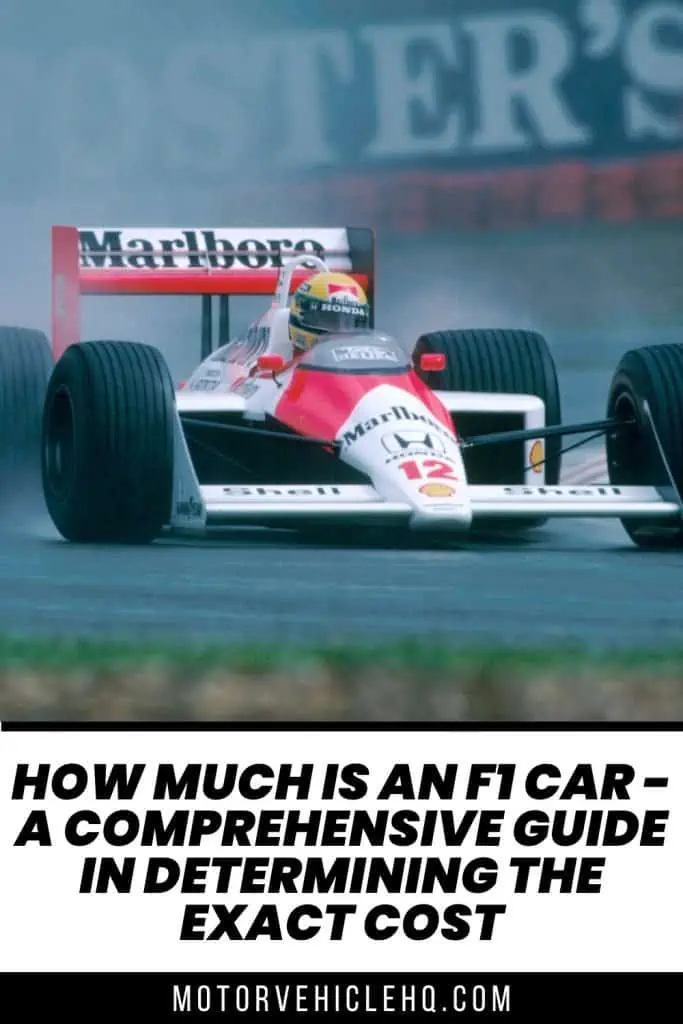
The dominant McLaren F1 car by Instituto Ayrton Senna / CC BY 2.0

Jim Wicks is the founder of MotorVehicleHQ. With over two decades of experience in the automotive industry and a degree in Automotive Technology, Jim is a certified car expert who has worked in various roles ranging from a mechanic, car dealership manager, to a racing car driver. He has owned more than 20 cars over the past 15 years. Ask him about any vehicle you see on the road and he can tell you the make, model and year. He loves the aesthetics of all things cars, and keeps his vehicles in pristine condition.
In his free time, Jim enjoys getting his hands dirty under the hood of a classic car or taking long drives along the country roads. His favorite car? A 1967 Shelby GT500, a true classic that, according to Jim, “represents the pure essence of American muscle.”
